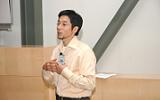3rd Human Rights Activism Lecture: Photograps from the Death Row, 17 December 2005

The 3rd Human Rights Activism Lectures was conducted on 17 December 2005. Satoshi Kazama, Japanese photographer, made a presentation titled “Photograps from the Death Row" on the stories of the adolescent inmates.
Satoshi Kazama is a photographer whose searing photographs of young people on death row bring a level of immediacy to the abolition debate that is often missing.
The New York-based photographer worked eight years gathering the images for “Youth of Death Row: A Documentary Exploration” and then toured venues including many college campuses to educate audiences to the truth about the death penalty.
The father of three, Toshi, who was born in Japan, says that raising his children in the U.S. forced him to study the country’s criminal justice and racial problems. He soon realized that he had three choices: he could sit by and ignore these issues; pack up and leave or work to help solve them.
He decided on the latter course and used his camera as a tool. He now tours the world showing his black and white photographs of the juveniles on death row and talks about his experiences photographing them.
At the heart of Toshi’s opposition to the death penalty is his belief that it is fundamentally unfair. “If you are poor in this country, your life is cheap. You can’t afford a good defense lawyer. If you’re rich, you’ll never get sentenced to death,” he says. Along with the economic polarity between rich and poor defendants, race hugely impacts the death penalty system, as most death row inmates are African-American and most of their victims white. “If you’re a poor minority your life is even cheaper,” he says.
Toshi takes a fierce interest in his subjects, reaching out to them on a personal level and getting to know not only their families but the families of their victims as well as the prison officials where they are incarcerated. He describes his subjects as “precious human beings” and hopes that his work will add to the effort to abolish the death penalty. At the very least, he wants his powerful photography to lead viewers to recognize the unacceptable levels of violence that permeate American society.
The death penalty system’s fallibility, leading to more than 100 inmates being released after being found innocent, is another reason to stop executions, he says. One of his subjects is among the exonerated.

